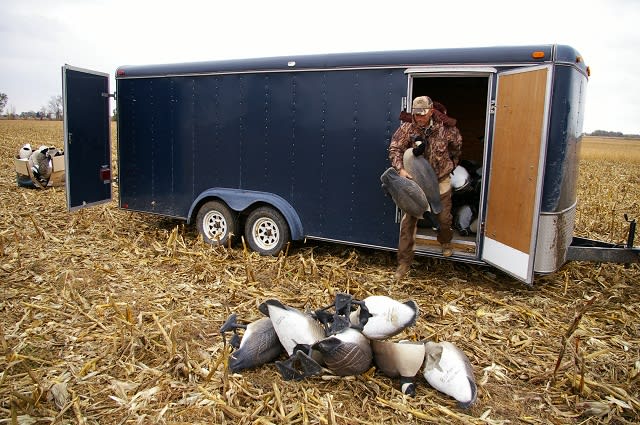Focus of Michigan Goose Hunting Shifts to Fields
Steve Griffin 10.24.12

Does it seem a little quieter in the duck marsh these days? Maybe that’s because it’s noisier in the croplands, where waterfowlers are taking aim at Canada geese.
Michigan regularly appears among the nation’s top five states in harvest of Canada geese, according to Barb Avers, wetlands and waterfowl specialist with the Department of Natural Resources Wildlife Division.
That bountiful goose harvest comes largely courtesy of flocks of locally produced giant Canada geese, which have mushroomed to nuisance levels in many areas.
Helping too are early, regular and late seasons that offer goose gunning somewhere in the state from late August through early February.

Maybe helping most of all is the emergence of field hunting for the big honkers, which has rewarded mobile hunters with some splendid shooting.
Some waterfowl hunters have beached their duck boats and floating blinds in favor of field goose hunting spreads. They drive country roads (and not too far into the country; some urban birds fly out daily to feeding and watering spots where shooting’s legal), trying to pin down the birds’ current feeding, watering and resting areas.
Having found a haunt and secured permission (generally, pretty easy unless the landowner hunts or has leased the land), hunters return pre-dawn or in mid-afternoon to deploy decoys counted in dozens, and to set and climb into layout blinds.
Nearly every sporting goods store now offers a range of ground blinds for the horizontal hunter, camouflage jacks-in-the-box from which the hunter can rise and take aim at decoying birds.
Some blinds are built for low price and lightweight. Others have superior waterproofing, high-tech internal hunter-supporting frames and more for those with more generous wallets–like a truck, trailer or quad to carry gear into the field.

Any blind-entry level to deluxe-can be made more invisible and thus more effective by adding corn stalks or similar material to it. Most have loops into which the stuff can be threaded.
Into the blind, then, the hunter slips, and the wait begins. Will the birds repeat their earlier visits? Can others be drawn from their flights to this spot made so apparently popular? Calling can help–unless experience with hunters has taught the birds to be call-shy.
Field shooting works best when a hunt captain creates the decoy pattern, directs the calling and issues a “shoot!” command when the birds have committed to landing and the rest of the party can share good shooting opportunities. It helps to have a retrieving dog along, too, to pursue cripped birds.
When it’s right, field goose hunting can be thunderous excitement: big-bore shotguns booming, honkers yelping as they reach for the sky – joyous noise to those who love the honkers of fall.
For more information on Michigan hunting go to michigan.org.

